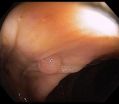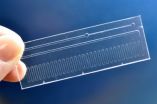(Press-News.org) What happens on the day before a colonoscopy may be just as important as the colon-screening test itself.
Gastroenterologists at Washington University School of Medicine in St. Louis have found that when patients don't adequately prep for the test by cleansing their colons, doctors often can't see potentially dangerous pre-cancerous lesions.
Reporting in the journal Gastrointestinal Endoscopy, the researchers say that doctors often missed at least one pre-cancerous growth in about one-third of patients who did not properly prepare for their colonoscopy. Those polyps and other markers of cancer risk were only discovered months later when patients had their next colonoscopy.
Although several studies have found that up to a quarter of colonoscopy patients don't prepare adequately for the test, the new study is the first to point out the potential consequences of poor bowel preparation in outpatients at average risk.
"Because so many of the patients had a follow-up screening less than a year after the initial test, we strongly suspect that most of the pre-cancerous growths found during the second colonoscopy already were present at the time of the initial test," says first author Reena Chokshi, MD, a gastroenterology fellow at Washington University.
The researchers say their findings suggest that if a physician is having difficulty seeing the colon due to inadequate bowel prep, the colonoscopy should be stopped and rescheduled.
"We often can detect preparation problems during the first few minutes of the procedure," Chokshi says. "And based on this study, we would say that rather than subjecting a patient to the potential risks of a full colonoscopy when we may not be able to detect polyps, or other pre-cancerous growths called adenomas, it may be better to bring that patient back as soon as possible for a repeat procedure with better bowel preparation."
On the day before a colonoscopy exam, people are asked to stop eating solid food and to consume only clear liquids. Later in the day and the next morning, patients drink bowel-cleansing mixtures to empty the colon prior to the examination.
The test itself usually takes less than an hour, and patients are sedated during that time. Using a tiny camera, doctors are able to look at the walls of the colon in an attempt to detect polyps and other pre-cancerous growths. Once detected, those growths can be removed during the course of the colonoscopy. Patients often must miss two days of work: the day of preparation and the day of the test. Recently, the outpatient endoscopy center at Washington University and Barnes-Jewish Hospital in St. Louis has begun screening patients on Saturday mornings to reduce the number of vacation days some patients have to use.
"Many patients say that the bowel preparation before the colonoscopy is the worst part of having the test, but it's also very important because in order to see polyps or cancers, we really have to be able to clearly see the entire wall of the colon," says senior author Jean S. Wang, MD, PhD, assistant professor of medicine in the Division of Gastroenterology. "Inadequate preparation makes that very difficult for a physician."
The researchers retrospectively studied patients who had an average risk of colon cancer and got screening colonoscopies in the outpatient endoscopy center. Individuals with a history of inflammatory bowel disease, a family history of colorectal cancer or a medical history of colon polyps were not included in the study.
AUDIO:
Proper preparation for a colonoscopy exam may be almost as important to the eventual detection of colon polyps as the screening test itself. Up to one in four colonoscopy patients...
Click here for more information.
In the five-year span between 2004-09, 373 patients at the center were identified as having inadequate bowel preparation. Of the 133 patients who later had a second colonoscopy during the study period, 33.8 percent had at least one pre-cancerous adenoma detected in that repeat screening. And almost one in five of that group were considered to be at high risk for colon cancer because they either had more than three adenomas detected, or the test discovered at least one large lesion.
In fact, the researchers found that 18 percent of the patients who had a second colonoscopy would have been given different recommendations if their polyps and adenomas had been detected during the initial screening, such as more frequent colonoscopies to monitor the development of growths in the colon.
"It generally takes several years for an adenoma to become cancerous," Chokshi says. "But it's hard to know where in that sequence a particular adenoma is when we detect it. So it certainly is possible that any lesion we miss during a colonoscopy could develop into a malignancy before a person's next colonoscopy, especially if it doesn't happen until 10 years later."
INFORMATION:
Chokshi RV, Hovis CD, Hollander T, Early DS Wang JS. Prevalence of missed adenomas in patients with inadequate bowel preparation on screening colonoscopy. Gastrointestinal Endoscopy, vol. 75, 2012 [Epub. ahead of print]. 10.1016/j.gie.2012.01.005
Washington University School of Medicine's 2,100 employed and volunteer faculty physicians also are the medical staff of Barnes-Jewish and St. Louis Children's hospitals. The School of Medicine is one of the leading medical research, teaching and patient care institutions in the nation, currently ranked sixth in the nation by U.S. News & World Report. Through its affiliations with Barnes-Jewish and St. Louis Children's hospitals, the School of Medicine is linked to BJC HealthCare.
Poor colonoscopy prep hides pre-cancerous polyps
2012-03-27
ELSE PRESS RELEASES FROM THIS DATE:
Research into children with autism published in JoVE
2012-03-27
Though the prevalence of autism spectrum disorder (ASD) has been steadily climbing— from 6 in 1,000 children in 2002, to nearly 10 in 1,000 children in 2006, according to the Centers for Disease Control and Prevention— little is known about the disorder. But, research with young kids can lead to important insights in how children with developmental abnormalities view the world. This month in the Journal of Visualized Experiments, researchers demonstrate how to use eye-tracking in very young children with autism.
"Generally, individuals new to this method often struggle, ...
Harvard’s Wyss Institute creates living human gut-on-a-chip
2012-03-27
Researchers at the Wyss Institute for Biologically Inspired Engineering at Harvard University have created a gut-on-a-chip microdevice lined by living human cells that mimics the structure, physiology, and mechanics of the human intestine—even supporting the growth of living microbes within its luminal space. As a more accurate alternative to conventional cell culture and animal models, the microdevice could help researchers gain new insights into intestinal disorders, such as Crohn's disease and ulcerative colitis, and also evaluate the safety and efficacy of potential ...
Sandia National Laboratories' Ion Beam Laboratory looks at advanced materials for reactors
2012-03-27
ALBUQUERQUE, N.M — Sandia National Laboratories is using its Ion Beam Laboratory (IBL) to study how to rapidly evaluate the tougher advanced materials needed to build the next generation of nuclear reactors and extend the lives of current reactors.
Reactor operators need advanced cladding materials, which are the alloys that create the outer layer of nuclear fuel rods to keep them separate from the cooling fluid. Better alloys will be less likely to deteriorate from exposure to everything from coolant fluids to radiation damage.
Operating a reactor causes progressive ...
Boston University researchers develop microfluidic chip to stem flu outbreaks
2012-03-27
BOSTON -- The H1N1 flu pandemic in 2009 underscored weaknesses in methods widely used to diagnose the flu, from frequent false negatives to long wait times for results. Now Boston University researchers have developed a prototype of a rapid, low-cost, accurate, point-of-care device that promises to provide clinicians with an effective tool to quickly diagnose both seasonal and pandemic strains of influenza, and thus limit the spread of infection.
Boston University Biomedical Engineering Associate Professor Catherine Klapperich led the team of engineering and medical researchers ...
Researchers discover a new path for light through metal
2012-03-27
WASHINGTON -- Helping bridge the gap between photonics and electronics, researchers from Purdue University have coaxed a thin film of titanium nitride into transporting plasmons, tiny electron excitations coupled to light that can direct and manipulate optical signals on the nanoscale. Titanium nitride's addition to the short list of surface-plasmon-supporting materials, formerly comprised only of metals, could point the way to a new class of optoelectronic devices with unprecedented speed and efficiency.
"We have found that titanium nitride is a promising candidate ...
WTFast.com Destroys Lag and Gives First-Person Shooter Gamers a Competitive Advantage From Anywhere Around the World
2012-03-27
Using unique proprietary technology, WTFast accelerates the online connection between gamers and servers, dramatically increasing performance for the world's most popular franchises. WTFast users can see drastic improvements in performance boosting game connection speeds by as much as 70 per cent. This is vital for gamers who live remotely from the host game servers.
"Our service gives its users a huge advantage in multiplayer FPS games regardless of where you are in the world," said Rob Bartlett, CEO of WTFast. "In some cases we've seen ping rates drop ...
When we test, do we stress?
2012-03-27
Your mother had a doctor's appointment for a memory test. The results are conclusive: she presents with the first signs of Alzheimer type dementia. Now, to get to her appointment, your mother, who is no longer used to driving in town, took her car, looked for a parking space for 15 minutes, got lost in a labyrinth of one-way streets, had never used those new electronic parking meters before and is convinced that the "machine" stole her credit card number. Out of breath, she walked 20 minutes looking for the doctor's office and finally arrived late for her appointment, even ...
Nicaragua Sets New Record in FDI Attraction
2012-03-27
The Government of Nicaragua recently revealed that the country received US$967.9 million in foreign direct investment (FDI) during 2011, a new record for the country in FDI inflows and a 91 percent growth when compared to the US$507.9 million attracted in 2010.
The FDI attracted in 2011 was led mainly by the energy, telecommunications and free zones sectors, which together accounted for 52 percent of total FDI. The development of these sectors has contributed significantly in increasing the country's productive capacity and boosting its economy.
Specifically, in the ...
University of Maryland completes most extensive full face transplant to date
2012-03-27
Baltimore, MD -- The University of Maryland released details today of the most extensive full face transplant completed to date, including both jaws, teeth, and tongue. The 36-hour operation occurred on March 19-20, 2012 at the R Adams Cowley Shock Trauma Center at the University of Maryland Medical Center and involved a multi-disciplinary team of faculty physicians from the University of Maryland School of Medicine and a team of over 150 nurses and professional staff.
The face transplant, formally called a vascularized composite allograft (VCA), was part of a 72-hour ...
Finding reason in delusion
2012-03-27
Dementia -- an acute loss of cognitive ability -- can be marked by memory loss, decreased attention span, and disorientation. It occurs in severe disorders such as Alzheimer's disease. Despite the fact that the condition is common, especially among older persons, there is still a lack of effective treatment.
According to Prof. Jiska Cohen-Mansfield of Tel Aviv University's Herczeg Institute on Aging and Sackler Faculty of Medicine, dementia sufferers are often prescribed psychotropic drugs to mitigate symptoms such as delusions. But this tactic can cause more harm than ...



